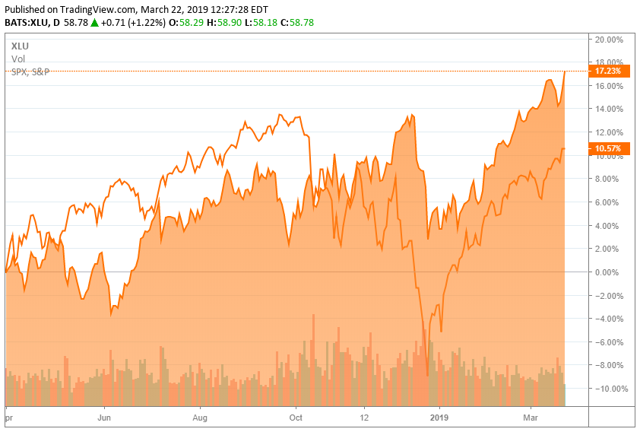[ad_1]
Want to make money in the stock market?
It’s a simple question, and for the past 12 months, the simple answer has been: Buy a stock or an exchange-traded fund (ETF) that focuses on the utility sector.
While some investors in the utility sector prefer to pick individual stocks, others prefer using an ETF such as the Utilities Select Sector SPDR ETF (XLU).
XLU allows an investor to benefit from a range of utility stocks, thus allowing greater diversity in their investment while still being able to buy and sell as shares trade throughout the day, unlike a mutual fund.
One of the reasons the XLU is so popular is its liquidity. With assets $9 billion, the ETF is easy to trade into and out of in times of market turmoil.
XLU is particularly useful for investors who do not have the time or inclination to do research on individual companies. Currently, the XLU ETF contains 28 stocks, including most of the largest utility companies operating in the U.S.
The index tracks a set of S&P 500 utilities weighted according to their market capitalization.
While utility stocks are regarded as relatively safe investments, no single company stock is truly safe from all eventualities, as exampled by Pacific Gas & Electric (PCG), which filed for bankruptcy after being hit by lawsuits related to California’s wildfires.
Holding a diversified portfolio protects investors from that sort of nasty surprise and XLU gives the investor that diversity with less risk.
Performance
As a sector, utilities have well outpaced the S&P 500 over the past 52 weeks, with the XLU rising by more than 17% compared to a 10% rise in the S&P 500 Index.
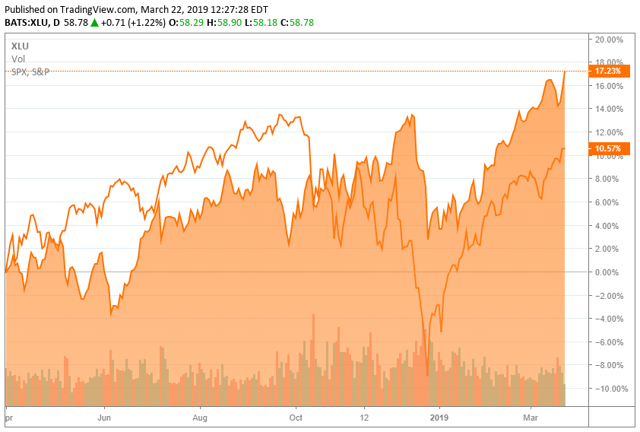
(Source: Seeking Alpha)
As you can see, most of the outperformance has occurred since last autumn.
Of course, you don’t have to buy the XLU.
If you prefer picking individual stocks, just about any utility (with the exception of Pacific Gas & Electric) you hung onto since March 2018 would have made you money.
Of the largest utilities based on market cap over the past 12 months, they all have handily beat the S&P 500:
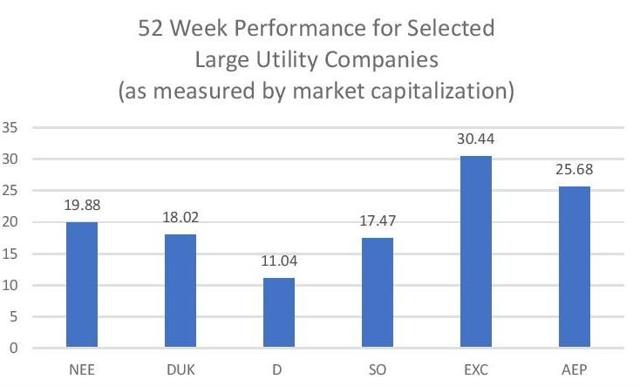 (Data Source: Seeking Alpha)
(Data Source: Seeking Alpha)
And this bounty isn’t confined to the largest utilities. Here are the 12-month gains for some of the smallest investor-owned U.S. utilities, as measured by market cap.
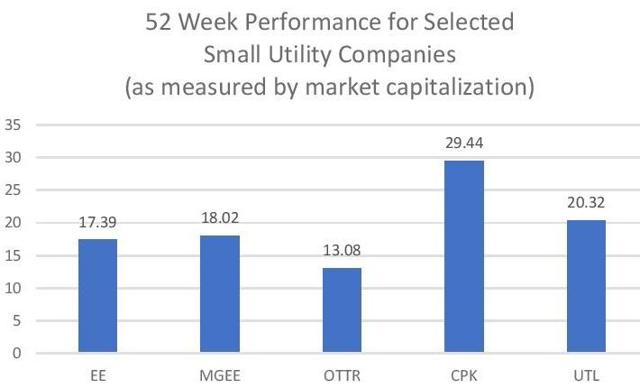 (Data Source: Seeking Alpha)
(Data Source: Seeking Alpha)
Heck, you don’t even have to know what company each of the stock symbols represent. Had you picked any of the above, you can see the positive results versus the S&P 500.
Why this performance is a danger signal to utility investors
The Utilities Select Sector SPDR ETF has seen 10 consecutive weeks of growth.
I submit that Tech and other high-growth oriented investors have not suddenly decided that providing electricity and gas to customers is a cutting-edge activity.
This outperformance by utility stocks is not being driven by investors’ expectations of the sector’s superior prospects compared to other industries such as tech, but rather is a defensive reaction to concerns about a general economic slowdown.
The performance of the Treasury yield curve is causing concern that it might be forecasting a recession later this year with a corresponding drop in the stock market.
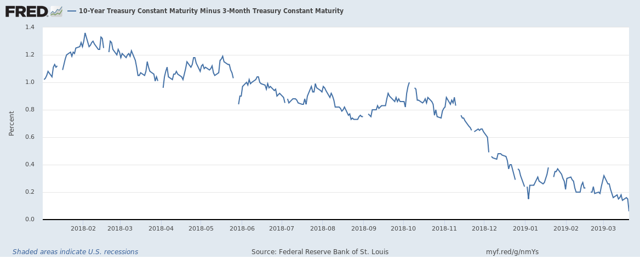 (Source: St. Louis Federal Reserve FRED)
(Source: St. Louis Federal Reserve FRED)
With the Treasury’s 3-month bill yield about to invert compared to the yield for the 10-year note, investors’ worries are driving them into utilities.
Whether you invest in the XLU or in individual stocks, this influx of money from investors who have previously avoided this sector is causing stock price increases for all companies in the utility sector and driving up their price/earnings (P/E) ratios.
Think of the old cliche: “A rising tide lifts all boats.”
Institutional and individual investors are looking for a safe place to hide, and utilities appear to be their answer.
Past performance in recessionary and post-recessionary times
Utility stocks are a good investment to guard against a slowing economy, but in a real recessionary period, they have not proven to have a magical shield against losses.
Officially, the last recession began in December 2007. If you look at the XLU for the 12 months ending in December 31, 2008, you can see that it lost 31% of its value.
Yes, still less than the S&P 500, but by no means were utility stocks a safe haven.
Unless you believe that the economy will stay slow, but not fall into recession, utilities are not a long-term insurance policy against losing money.
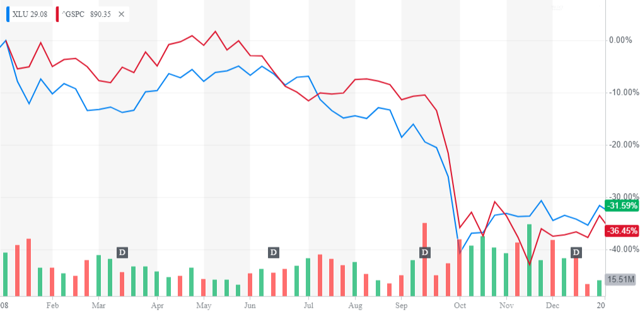 (Source: Finance.Yahoo.com)
(Source: Finance.Yahoo.com)
Of course, as the economy recovered after the last recession, the S&P went on to outperform the utilities sector as investors went back to higher growth-oriented stocks as the chart below shows from 2010 to 2013.
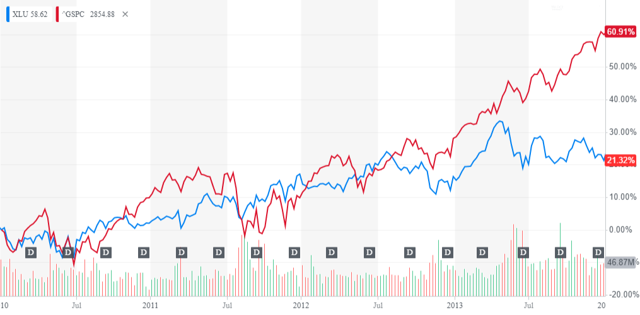 (Source: Finance.Yahoo.com)
(Source: Finance.Yahoo.com)
Message: Utility investors have two ways to lose money.
If the economy slips into a real recession, expect utility stock prices to drop along with all other stocks.
Or, if the economy reverses course and picks up a head of steam, expect non-utility focused investors to abandon utility stocks for higher growth stocks, also causing utility stock prices to decline either in absolute terms or relative to the overall market.
If I am right, then it is likely that just as these non-utility focused investors have moved into utility stocks, pushing up their prices today, they will sell out of their utility stocks at some point, driving down prices either in absolute or relative terms.
To belabor the tide analogy, if a rising tide lifts all boats, then the boats will drop when the tide goes out.
Worth trading utility stocks?
While utilities are at these inflated levels, for individual stock pickers is it worth trading one utility stock for another stock?
There can be value if you can find a stock that is underpriced relative to other utilities, but the market is proving fairly efficient in its current pricing.
Look at those largest cap stocks. Using forward P/E ratios, markets are fairly pricing stocks.
Yes, with a forward P/E of 17 for Southern Company (SO), it is lower than the P/E of 23 for NextEra Energy (NEE) (with Southern Company carrying a dividend yield advantage of 200 basis points), but that reflects investors’ continuing concern over Southern Company’s future prospects related to its commitment to its nuclear power project.
Likewise, there are utility stocks carrying an above-market dividend yield of more than 5%, such as National Grid (NGG), but that is of course because investors are afraid of the results from Brexit, including a lower British pound that will devalue their investments.
Your yield is more, but so is your risk.
Overall, the P/E ratios for the other large cap stocks fall in between NEE and SO, as do their prospects, but there are no glaring disparities, and you have to be careful that your trading costs do not eat up your expected advantages of trading one utility for another.
The dividend yield for XLU is currently around 3%, which is better than the yield on a 30-year Treasury bond and another reason investors are moving into utility stocks.
What’s a utility investor to do in these current circumstances?
If you are a long-term utility investor (either in the XLU or in individual stocks), you have two favorable choices that mostly depend on your personal disposition.
One, you can sell some stock at the current high prices, bank the profits, and sit out the current market to await more favorable buying opportunities.
Whatever stock you own must be offering you double-digit long-term capital gains by now, so selling some stock and taking profits seems reasonable.
Two, if selling any stock seems abhorrent to you even with these large profits (and I know lots of long-term investors who feel that way and are strictly buy-and-hold investors), then ignore current prices and do nothing.
In either case, at these prices, I wouldn’t add to my utility portfolio but wait for a more favorable climate.
Don’t get caught up in the current buying spree and add significant holdings at these prices but rather show patience.
The stock market seems undecided about future direction, which explains the interest in utilities, but sooner or later it will decide, and when it does, I expect utility stock prices to fall for the reasons I gave above.
Conclusion
For myself, I have trimmed my utility investments (but not sold out of the sector altogether).
I still own stakes in Exelon (NYSE:EXC), Fortis (FTS), and National Grid, but as a long-term utility stock investor, I can bank my profits and wait while I continue to receive dividends on those shares I keep in my portfolio.
While only Exelon of this group is currently included in the XLU holdings, all three are “enjoying” the influx of investors’ funds into this sector.
Enjoy the dividends and/or take profits, and wait for the inevitable time when utility stocks fall out of favor to add to your utility investments.
It is a good time to be a utility investor, if you don’t get greedy.
Disclosure: I am/we are long EXC, FTS, NGG. I wrote this article myself, and it expresses my own opinions. I am not receiving compensation for it (other than from Seeking Alpha). I have no business relationship with any company whose stock is mentioned in this article.
[ad_2]
Source link Google News

